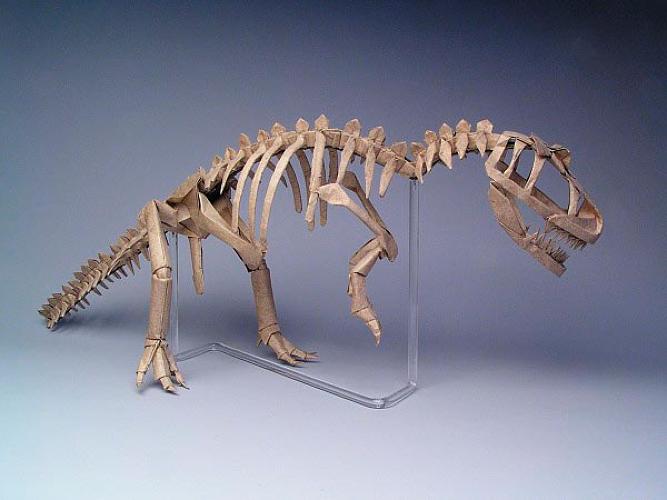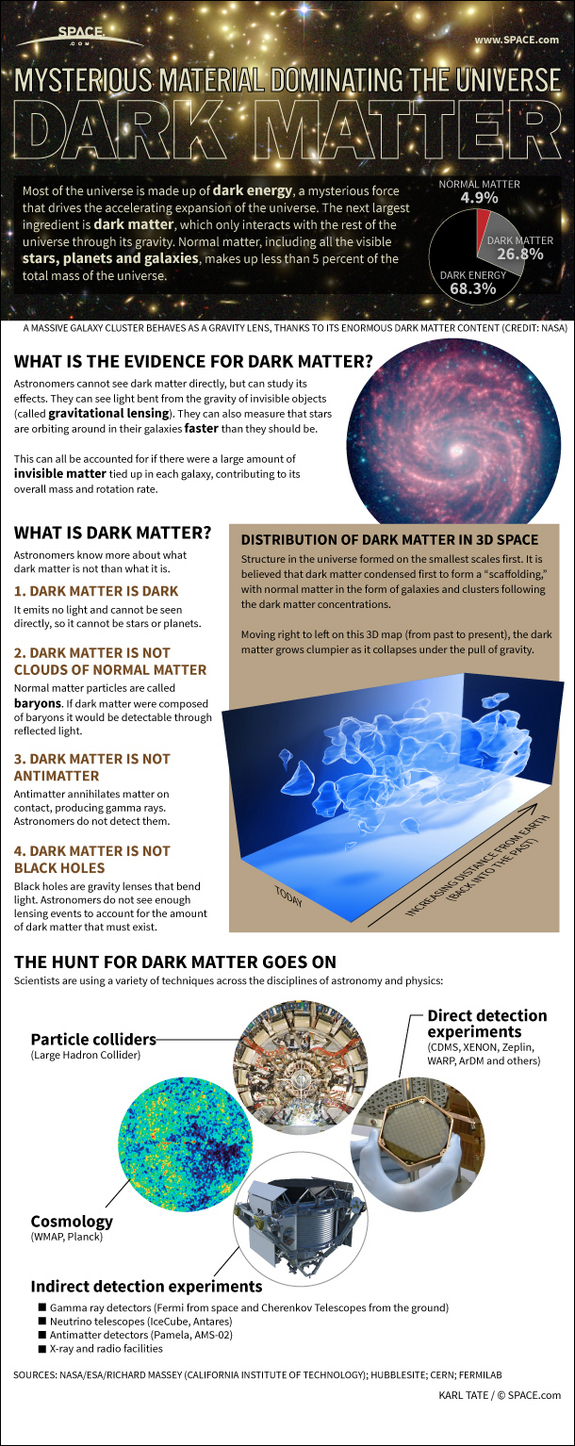Tuesday, July 28, 2015
Higgs to Heavy Metal
As it turns out, pretty good.
Take two figures of Higgs Boson data and turn it into music and you get this:
See more at:
http://cylindricalonion.web.cern.ch/blog/201504/what-would-higgs-discovery-sound-heavy-metal-song
Tuesday, January 6, 2015
Thursday, July 17, 2014
Origami Science
Robert J. Lang is a former NASA laser physicist who combines his knowledge of math and science to create origami masterpieces. His pieces are known for their great detail and realism, and they are some of the most complex origami designs ever created.
Lang groups the origami science into three categories:
- Origami Mathematics - This is a subset of mathematics using one of the simplest sets of operations called "Huzita-Justin Axioms." This os set of six (possibly seven?) distinctly different ways to create a single crease by alligning one or more combinations of points and lines expanded with origami geometric constructions that solve for an exact angle quintisection.
- Computational Origami - This is a subset of computer science that uses computational geometry, and the associated algorithms, as a tool for origami design and computations.
- Origami Technology - This is the application of origami techniques to real-world solution making problems in fields like engineering and industrial design. Think: How to fold an car's airbag or folding a telescope.
Here are some of my favorites:.
 |
| PRAYING MANTIS, OPUS 416 Composed and folded: 2012; One uncut square of paper 4" Image: Emre Ayaroglu/Flickr via Science Alert |
 |
| AEDES AGEYPTI, OPUS 619 Composed and folded: 2012, Commissioned by The New Yorker Magazine c/o Robert Lang via Fast Company |
 |
| THE SENTINEL II, OPUS 627 Composed and folded: 2012; Two uncut squares of Korean hanji, 14" Photo by Susan Karlin via Fast Company |
 |
| ALAMO STALLION, OPUS 384 Composed: 2001, folded 2012; One uncut square of Origamido paper 12" c/o Robert Lang via Fast Company |
 |
| ALLOSAURUS SKELETON, OPUS 326 16 uncut squares of Wyndstone Marble paper 24" c/o Robert Lang via Fast Company |
Stories that include more photographs and videos of Lang's wonderful origami creations:
Robert J. Lang's Origami Website
Fast Company "Art Folds into Science in Robert Lang's Extreme Origami"
Williamson Gallery's Information on "Folded: The Origami of Robert J. Lang"
Science Alert "Behind the science of Robert J. Lang's origami"
Wednesday, June 11, 2014
Engage Warp Drive, Mr. Sulu!
A warp drive may actually become a real thing. Permission to get a little excited.
A couple of years ago, several stories hit the internet when physicist Harold White announced that his NASA team at the Johnson Space Center had begun work on the development of a warp drive. You can probably see how news of potential faster-than-light-speed travel might throw geeks into a Star Trek-fueled frenzy. White proposed a design that would solve the problems of the Alcubierre Drive concept. Most people have never even heard of this, much less know how to pronounce it. To really understand the basis of your excitement, you should probably understand this concept.
Miguel Alcubierre is a Mexican born physicist that specializes in numerical relativity, using computers to formulate and solve Einsteinian field equations. In 1994, Alcubierre published a paper in Classical and Quantum Gravity titled "The Warp Drive: Hyper-fast travel within general relativity." In this paper he describes the Alcubierre Drive, a theoretical means of traveling within the framework of general relativity, and without the introduction of wormholes, that allows a spaceship to travel faster than the speed of light. This statement is a little weird considering the velocity of light speed limit as viewed by special relativity and general relativity. In the context of special relativity, the speed of light is the absolute fastest that anything with real mass can move (I'm not getting into tachyons right now) because relativistic mass increase limits massive objects to slower-than-light velocities. Put very simply, you gain mass the faster you go which then requires more energy to make you go faster. General relativity doesn't really forbid faster-than-light travel, but it does require the restrictions of special relativity locally to a region of space. Think: Speed limit on a specific section of highway. A way to get around this locality problem is the wormhole (Think: Shortcut) which, because it is providing a way to travel between two widely spaced locations in a shorter amount of time, results in an effective speed faster than that of light.
Another way to beat the speed of light limitation is to use the expansion of the universe itself. And this is what Alcubierre proposes. As the universe expands, new space is being created between two objects. Obviously, the universe is really big (biggest understatement ever) and so when we talk about expansion we are talking huge scales. But Alcubierre's theory uses this concept on a more local scale.
"The basic idea can be more easily understood if we think for a moment of the inflationary phase of the early Universe, and consider the relative speed of separation of two co-moving observers. It is easy to convince oneself that, if we define this relative speed as the rate of change of proper spatial distance over proper time, we will obtain a value that is much larger than the speed of light. This doesn't mean that our observers will be travelling faster than light: they always move inside their local light-cones. The enormous speed of separation comes from the expansion of spacetime itself."

Okay, reality time. Should you be excited about this? Absolutely! But also keep in mind that seeing this technology for real is still a long way off. So be excited, but be realistically excited.
Miguel Alcubierre's paper:
"The Alcubierre Warp Drive" by John G. Cramer. A really really good explanation of the paper from the University of Washington's Center for Experimental Nuclear Physics and Astrophysics (CENPA). A source I used for a lot of the explanation above, including the reproduction of the figure from the original paper.
Here are some news stories about White's original announcement:
Gizmodo's "NASA Starts Work on Real Life Star Trek Warp Drive"
Some new stories about the release of the concept art:
Science Alert's "NASA's design for a warp drive spaceship is AMAZING"
iO9's "Here's NASA's New Design for a Warp Drive Ship"
Sploid's "NASA's real life Enterprise may take us to other star systems one day"
Monday, March 17, 2014
The Physics of Cow Tipping
Monday, October 7, 2013
Bohemian Gravity!
Tuesday, April 16, 2013
What You Should Know About Dark Matter
Source SPACE.com: All about our solar system, outer space and exploration
Tuesday, July 10, 2012
Happy Birthday Niki T!
Now, via The Oatmeal...
Friday, June 1, 2012
Wednesday, October 5, 2011
Faster Than a Speeding Photon
I've been avoiding posting about this story because I'm not sure I'm totally on board with the results. But to say it has caught the news media and Internet on fire would be an understatement. So I've decided to go for it: Let's review the paper about neutrinos going faster than the speed of light.
Physics, especially particle physics, can get really complicated really fast. So, I think, to understand the significance of this finding you have to know some basics about fundamental particles. For that I suggest you go back and read my So Quarky post from back in 2010. Neutrinos are one of these fundamental particles belonging to the class of particles called leptons. They have no charge which means they are not affected by the electromagnetic force; they are only affected by the weak subatomic force. They are able to pass through large amounts of matter without being affected. Since it has mass, although extremely tiny, it is affected by gravity but that is the weakest of the forces. Neutrinos come from several sources. Most of them are left over from the big bang and make up part of the cosmic microwave background while others are produced in stars, beta decay, etc. We can also generate them in physics laboratories by colliding high energy particles into fixed or moving targets.
The speed of light is 299,792,458 meters per second (186,282 miles per hour). According to Albert Einstein's theory of special relativity, the speed of light (c) in a vacuum as a physical constant, a maximum speed at which all energy, matter, and information in the universe can travel. The speed of light is the speed of light no matter the motion of the source or the inertial frame of reference of the observer. It is the ultimate limit, the fastest a particle can move. So what happens when an experiment records a particle going faster than the speed of light?
The Oscillation Project with Emulsion-tRacking Apparatus (OPERA) lies 1,400 meters underground in the Gran Sasso National Laboratory (LNGS) in Italy. It was designed to "perform the first detection of neutrino oscillations in direct appearance mode in the νμ→ντ channel, the signature being the identification of the τ− lepton created by its charged current (CC) interaction." Um, ok. In addition to this main goal, OPERA is also suited accurately determine neutrino velocity though the measurement of the time of flight and distance from the source. CERN (the European Organization for Nuclear Research), 730km away, fires a beam of neutrinos through the earth to OPERA, a 2.43-millisecond trip for a photon. A total of 16111 events were collected over three years. They found that, on average, the neutrinos arrived 60 nanoseconds faster than expected if they were traveling at the speed of light.
Whoa.
Now take a couple of logical steps past that. If neutrinos go faster than the speed of light (even a little bit) then are we getting into the realm of tachyons and time travel? Possibly.
But wait...don't throw Einstein's theories out the window and don't start building that time machine just yet.
The big question now is whether these scientists have actually discovered particles going faster than the speed of light or if there is some type of error in their experiment that is making the velocity look artificially short. After all, this is an extremely sensitive measurement. We're talking unreacting particles that are lighter than an electron and time measured in nanoseconds. Right now there are all sorts of responses being talked about an published on this topic.
The consequences of these results would be huge, and one of the things I like about this experiment is the way in which it was presented. They didn't just announce "We've broken the speed of light!" The authors put the information out there -- here are our results -- asking scientists to independently confirm or deny these results and/or offer up explanations as to why these results were obtained.
What do you think?
Here is the prepublished paper:
Adam, T. et al. (2011) Measurement of the neutrino velocity with the OPERA detector in the CNGS beam. High Energy Physics - Experiment ( arXiv:1109.4897v1)
I also recommend reading through a few of these articles as they offer some great views from other physicists:
Science Magazine: Neutrinos Travel Faster Than Light, According to One Experiment
Nature News: Particles Break Light-Speed Limit
The Guardian: Faster Than Light Particles Found, Claim Scientists
Scientific American: Faster-Than-Light Neutrinos? Physics Luminaries Voice Doubts
The New York Times: Tiny Neutrinos May Have Broken Cosmic Light Speed
Wired Science: Can Neutrinos Move Faster Than Light?
New Scientist: Faster-Than-Light Neutrinos? New Answers Flood In
(image from physics.ubc.ca)
Saturday, May 14, 2011
Friday, May 6, 2011
Space-Time is Epic
When NASA posts a story about the results of an "epic space-time experiment" I just have to read it.
The story can be boiled down into four words: Einstein was right again.
Space-time is a mathematical model that combines space and time into a single continuum. If you look at the history in the formation of this model you'll find that it steps through the theories/rules of some well known mathematicians. The explanation of space-time didn't start with them all put together and hyphenated, it started with simple geometry and the Pythagorean Rule (you remember that from 8th grade geometry class right? a2 + b2 = c2). When that wasn't enough a Euclidean model for space was was used (he was the one that built the coordinate system). The Euclidean model explained space in terms of dimensions, with the universe consisting of three dimensions of space and one dimension of time. By Newton's time, people were getting pretty good at explaining space using a Euclidean distance function but it did not work when gravity becomes strong. Newtonian physics took the model a further but still had some problems including dealing with the speed of light and gravity. Then Einstein came up with the concept of special relativity. It explained observations like that the speed of light is constant everywhere and in every direction. Einstein's theory of gravity provided a geometric understanding of gravitation.
According to Einstein, space and time are woven together, forming a four-dimensional fabric called space-time. The mass of a large object causes that fabric to curve or dimple. Think of it like a big rubber sheet that has a heavy ball set on top of it. That is how space-time curves around a planet or star. Now let's add gravity to the mix. Einstein explained gravity as the motion of objects following the curvaceous lines of the dimple. Think of it like a very large funnel that you spin a small ball around, starting at the edge it will slowly spin around to the bottom/center of the funnel. Alright, now lets make the object, the Earth, move. As the planet spins the dimple twists, pulling it around into a four dimensional swirl. That's the theory at least.
NASA went to test this theory with its Gravity Probe B (GP-B). The experiment is actually pretty simple. Put a spinning gyroscope into orbit around the Earth, with the axis pointed at a distant star as a reference point. If the gyroscope is free of external forces the axis should continue pointing at the star for forever. If it not free of external forces, if space is twisted, then the direction of the axis will drift over time. Note the direction of the dirft and you can measure the twists of space-time. The twisted space-time around the Earth should cause the axis of the gyroscope to drift about 0.041 arcseconds (1/3600 of a degree) over a year.
Admittedly, that is a pretty simple concept, but the actual conducting of the experiment is not so simple. GP-B has four gyroscopes. These gyroscopes are about the size of ping pong balls and contained the most perfect spheres ever created by humans. They are made of fused quartz and silicon that never vary from a perfect sphere by more than 40 atomic layers. And because the drift of the gyroscopes would be so small the instruments had to have a precision of 0.0005 arcseconds. Whoa. But we're not done yet. The satellite the gyroscopes were one needed to be drag free so that when it brushed against the outer layers of the atmosphere the gyroscopes would not be disturbed. The satellite also had to keep the Earth's magnetic field from penetrating the spacecraft. And then they created a device that measured the spin of the gyroscope without touching the gyro. Is your jaw on the floor yet because I know mine is.
After a year of taking data and five years of analysis the results are in: A geodetic precession of 6.600 plus or minus 0.017 arcseconds and a frame dragging effect of 0.039 plus or minus 0.007 arcseconds.
Uh. Ok. Well, let's break that down. Geodetic precession is the amount of wobble caused by the static mass of the Earth (the dimple in space-time) and the frame dragging effect is the amount of wobble caused by the spin of the Earth (the twist in space-time). These results are in precise accord with Einstein's predictions. It is evidence that the predictions in Einstein's theory are correct and that it can be applied to other objects in the universe.
Yep, Einstein was the man. Epic.
Here's the news report from NASA: http://science.nasa.gov/science-news/science-at-nasa/2011/04may_epic/
The Gravity Probe B mission homepage: http://einstein.stanford.edu/
Learn more at Spacetime 101: http://www.theory.caltech.edu/people/patricia/st101.html
And finally, here are a few more NASA stories on this topic you may find interesting:
A Pocket of Near Perfection - http://science.nasa.gov/science-news/science-at-nasa/2004/26apr_gpbtech
Was Einstein a SpaceAlien? - http://science.nasa.gov/science-news/science-at-nasa/2005/23mar_spacealien
In Search of Gravitomagnetism - http://science.nasa.gov/science-news/science-at-nasa/2004/19apr_gravitomagnetism
(images from the NASA story linked above)
Saturday, January 1, 2011
Bad Movie Physics Report Card
Anyway, that's my mini-rant. A rant that is related to the subject matter for today's post.
IO9 has posted a Bad Movie Physics Report Card where they rated 18 movies based on how many laws of physics they broke. We all know that space movies bend, if not outright mangle, the rules of physics just to travel around in their chosen media. After all, a light year does, in fact, take a year to complete, and who wants to watch that? For the most part, the categories that IO9 used are pretty self explanatory but they expanded on them a bit anyway:
- There's no sound in space
- Not all planets have Earth gravity
- Planets should have diverse climates, instead of one unified climate across a "desert planet" or "forest planet"
- It shouldn't be too easy to communicate with alien creatures, without some kind of high-technology "translator" explanation
- And it definitely shouldn't be too easy for humans to interbreed with aliens
- Humans exposed to vacuum without a spacesuit shouldn't explode or shatter. And a "hull breach" where the ship's crew is exposed to vacuum should kill everyone instantly
- You can't have fires in space, unless there's oxygen leaking out somehow
- Asteroids or other objects shouldn't be able to float close together without falling into each other's gravity
- People shouldn't be able to dodge lasers or other speed-of-light weapons
- And there's no reason why someone would move in slow-motion in zero gravity
- Faster-than-light travel is probably not ever going to be possible
This is the article: http://io9.com/367792/bad-movie-physics-a-report-card
Wednesday, November 24, 2010
What If
Monday, June 7, 2010
The Physics of Mentos
As of today the "Diet Coke + Mentos" video is at almost at 12 million hits and "The Coke Zero & Mentos Rocket Car" video has 2 million hits on YouTube (above). Not to mention a host of other videos on the same topic. So what's this all about, scientifically speaking?
Well, Coke and Mentos have a physical reaction. The nucleation sites in the pitted surface of the Mentos candy allows for the rapid formation of bubbles. The gelatin and gum arabic found in Mentos help to break the surface tension, allowing the rapidly forming bubbles to more rapidly form. When the candy sinks to the bottom of the Coke bottle the pressure from the forming bubbles/gas pushes the liquid up at a high rate.
A couple of years ago a paper was published in the American Journal of Physics looking at this physical reaction. They took two varieties of Mentos - fruit and mint - and scanned them with an electron microscope to look at the nucleation. They tested nucleation surfaces using the fruit Mentos, mint Mentos, liquid gum arabic, a mixture of Dawn Dishwashing liquid and water, table salt, rock salt, playground sand, Wint-o-Green Lifesavers, a mixture of baking soda and water, and molecular sieve beads. They observed these candy reactions in Coco-Cola Classic, Diet Coke, Caffeine Free Diet Coke Diet Coke, Caffeine Free Coca-Cola Classic, seltzer water, seltzer water with potassium benzoate added, seltzer water with aspartame added, tonic water, and diet tonic water. There were also temperature dependent trials where bottles were either refrigerated, heated, or kept at room temperature.
The results showed that drinks containing aspartame (a sweetener) and potassium benzoate (a preservative) to be more explosive than unsweetened drinks and drinks sweetened with sugar or corn syrup. This is probably due to a reduction in the work required for bubble formation. They found that the best nucleation sites were on the Mentos (both kinds) and that Mentos had a quick fall time which increased the number of bubbles coming from the bottom of the bottle, making it more explosive. Also, warmer Coke was found to have a larger explosion (due to Henry's Law).
So you want a big explosion? Place a Mentos with a lot of surface roughness in a diet Coke that has been heated.
Kaboom!!
Here's the article:
Coffey, T. (2008). Diet Coke and Mentos: What is really behind this physical reaction? American Journal of Physics: 76(6), 551-557. (DOI: 10.1119/1.2888546)
Also see:
"Episode 57: Mentos and Soda" of Mythbusters on the Discovery Channel (first aired August 9, 2006)
and
Eichler, Jack F., Heather Patrick, Brenda Harmon, and Janet Coonce. (2007) Mentos and the scientific method: A sweet combination. Journal of Chemical Education: 84(7), 1120–1123. (DOI: 10.1021/ed084p1120))
Thursday, April 8, 2010
Elemental
 A team of Russian and American scientists has discovered a new, still nameless, element. The paper, “Synthesis of a new element with atomic number Z=117,” will appear in the journal Physical Review Letters and was reported on in the New York Times yesterday.
A team of Russian and American scientists has discovered a new, still nameless, element. The paper, “Synthesis of a new element with atomic number Z=117,” will appear in the journal Physical Review Letters and was reported on in the New York Times yesterday.Six atoms of this new element were produced by smashing calcium and berkelium together in a particle accelerator. Once the experiment has been replicated and confirmed, the new element will receive its name. At the moment, it is being referred to as ununseptium, a reference to its atomic number, 117. An atomic number refers to the number of protons (subatomic, positively charged particles) in the nucleus of an atom; The number of neutrons can vary. Out of the six atoms created, five contained 176 neutrons, the remaining had 177.
Data from this experiment supports the hypothesis that newly created atoms will become heavier and heavier until they reach a more stable, longer-lived state. This "island of stability" is, and has not been, seen among many artificially created elements which have short, unstable life spans (high decay rates). Stable atomic nuclei occur when the outermost shells of protons and neutrons are filled. Some theories project the center of this "island of stability" to be at 184 neutrons and either 120 or 126 protons. This new element is one more step toward this island and, likely, one more square on the periodic table of the elements.
The NYT article: http://www.nytimes.com/2010/04/07/science/07element.html?src=mv
Monday, April 5, 2010
So Quarky

In thinking about how to start this story I figured that an itty bitty lesson in particle physics was in order. Now, a word of warning: I'm not, and have never been, a particle physicist. At least not in this dimension. So I'm going to try and keep it simple for your sake, my sake, and the sake of the word count. Here's hoping it comes out intelligible:
In modern theory we have the Standard Model, a name given to the theory of fundamental particles and their reactions (we're talking all the stuff that makes up protons, neutrons electrons, etc.). This theory has been extremely useful the field of particle physics as well as other areas of study that use its principles. You've no doubt heard all the news hype about the Higgs boson, particularly in relation to the Large Hadron Collider (LHC). The Higgs boson is an additional, as yet theorized but undiscovered, particle that lends mass to these other, fundamental particles.
What other particles? I'm glad you asked. They are the fundamental building blocks from which all else is made. In the Standard Model there are 12 fundamental matter particle types (and, of course, their corresponding antiparticles). These 12 types are divided into 2 classes, of 6 particles each, called quarks and leptons (the 6 being 12 if you count antiparticles). Since this story talks about quarks in particular I just define those. Quarks are the constituents of hadrons such as protons and neutrons. Remember I said there were 6 types? They are up (u), down (d), charm (c), strange (s), top (t), and bottom (b). They experience all four of the fundamental forces (electromagnetism, gravitation, strong interaction, and weak interaction), although gravity is negligible at these scales, and are grouped into 3 generations. The first (and only to be found in nature) being up and down quarks, the second charm and strange quarks, and the third top and bottom quarks.
Hopefully, that made something resembling sense. My brain hurts and we are just getting to the story.
A team of physicists, using more computing power and simulations than we can probably conceive of, have calculated the masses of up quarks and down quarks. This new calculation is 20 times more precise than previous ones. It could be a big help to scientists working at facilities such as the LHC, not to mention other theorists who could incorporate it into the Standard Model (which treats quark masses as arbitrary). It is known that quarks are bound together by the strong interacting force (strong force), but this hold is so tight that you can't isolate one quark from another. So you can't measure the mass of a single quark. Particles that are made up of quarks are, as you would expect, even more complex. A proton has two up quarks and one down quark while a neutron has two down quarks and one up quark -- all held together by gluons (quark interactions or vector bosons). Oh yeah, and don't forget to add the quark-antiquark pairs that come into and out of existence. When you start adding things up, the valence quarks (those original 3) make up under 2% of a proton's mass. This is where the theorists step in.
Physicists have used an approach called lattice quantum chromodynamics (lattice QCD) that simulates these particles within a hadron by modeling it as a grid of points (a lattice). When you place the quarks and gluons on the grid and simulate their interactions you can calculate the masses of hadrons. In the past, this procedure lended a sizable uncertainty to the masses of the quarks. Here, the scientists were able to calculate the ratios of the charm-quark mass to the strange-quark mass and then combine this with another group of ratios of strange-quark mass to up-quark mass and down-quark mass. The resulting ratios were of a much smaller uncertainty (from 30% to 1.5%) than in the past. "The team finds that an up quark weighs 2.01 +/- 0.14 megaelectron-volts, whereas a down quark weighs 4.79 +/- 0.16 MeV. That’s 0.214% and 0.510% of the mass of the proton, respectively." More testing needs to be done to see if these results hold up, but this is undoubtedly an extraordinary achievement.
Whew...I need a drink...
Get more of the story here: http://news.sciencemag.org/sciencenow/2010/04/mass-of-the-common-quark-finally.html
(image from startswithabang.com)
Wednesday, March 24, 2010
LHC on Speed
 CERN's Large Hadron Collider (LHC) has been in the news for some time - mainly because of its technical difficulties. But now that its up and functional it has been colliding particles at faster and faster speeds. And now the LHC is going to try to collide particles at the highest energy level so far in the attempt to recreate Big Bang conditions. Twin beams, which accelerate through a 16.78 mile circular underground tunnel, are currently at 3.5 tera-electron volts (TeV) and will be traveling at 7 TeV on March 30th. Of course, lining the beams up and getting particles to collide is a challenge, but once they start seeing results the plan is to run continuously for 18-24 months. That's a lot of data!
CERN's Large Hadron Collider (LHC) has been in the news for some time - mainly because of its technical difficulties. But now that its up and functional it has been colliding particles at faster and faster speeds. And now the LHC is going to try to collide particles at the highest energy level so far in the attempt to recreate Big Bang conditions. Twin beams, which accelerate through a 16.78 mile circular underground tunnel, are currently at 3.5 tera-electron volts (TeV) and will be traveling at 7 TeV on March 30th. Of course, lining the beams up and getting particles to collide is a challenge, but once they start seeing results the plan is to run continuously for 18-24 months. That's a lot of data!Dark matter, Higgs boson, and the birth of the universe...oh my!
Read more here: http://abcnews.go.com/Technology/wirestory?id=10178093&page=2
(image from theobservereffect.files.wordpress.com)



















